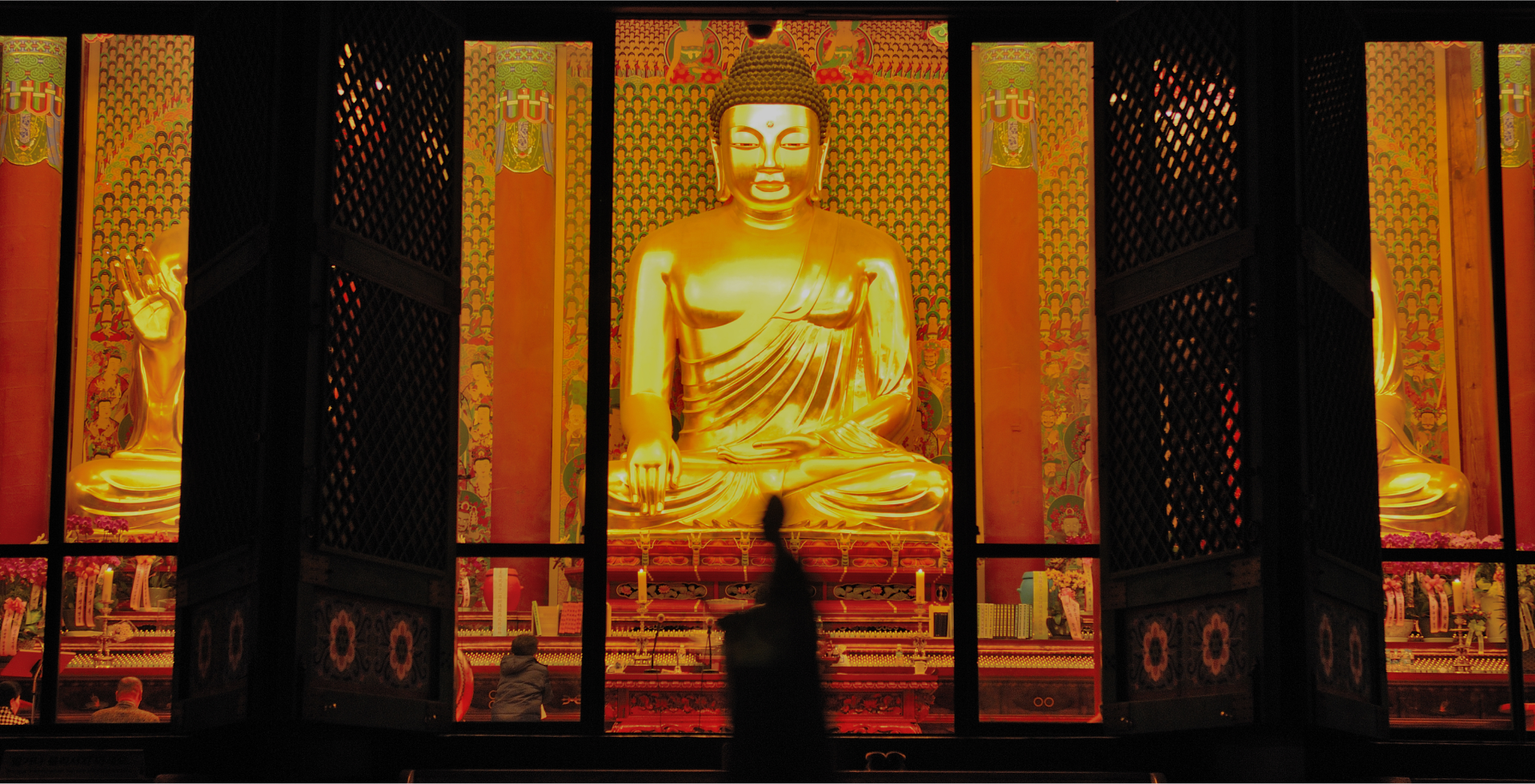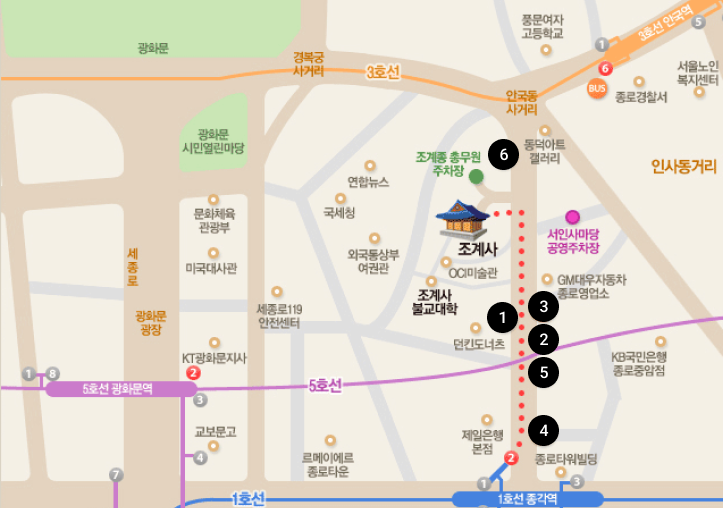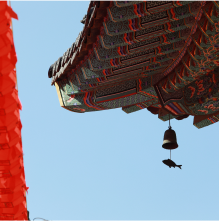
Access
How to get here
-
jogyesa
55, Ujeongguk-ro, Jongno-gu, Seoul, Korea
By Bus at

1BUS
01-202(Jogyesa) 109, 151, 162, 606, 1020
2BUS
01-201(Jogyesa) 151, 162, 172, 401, 406, 704, 7022
3BUS
01-267(Jogyesa) 5000A, 5000B, 5005, 5500-2, 9000, 9200, 9401
4BUS
01-893(Insa-dong, Aventree Hotel) 6005
By Subway
Line 1
Jonggak station Exit 2 - walk down along the road for 300m
Line 3
Anguk station Exit 6 - walk down for 150m - cross the street
- walk down for 150m
Attractions nearby
① Gyeongbokgung Palace : Established in 1395, Gyeongbok-gung was the royal
palace of the Joseon Dynasty where kings used to hold morning audiences. King
Taejo Lee Seong-gye, the founding monarch of Joseon ascended the throne at the
Suchang-gung Palace, a Goryeo Dynasty palace in Songdo (present-day
Gaeseong) on July 7, 1392. He then decided to move the capital, and the following
year he embarked on the construction of palaces and a castle town in Sindoan in
the vicinity of Mt. Gyeryong-san. However, this endeavor was later called off. In the
third year of King Taejo's reign, the capital was moved to Hanyang and Gyeonbok-
gung was completed the next year.
② Hanyang City Wall : This is a fortress wall that surrounded Hanyang, the capital of the Joseon Dynasty.
③ Insa-dong : Insa-dong is one of the representative cultural streets of Seoul in which tradition and modernity coexist in harmony. Every corner of Insa-dong is steeped in rich Korean history. The winding alleys and back streets of Insa-dong are filled with traditional tea shops, restaurants, calligraphy brush shops, galleries of modern and antique art, and handicraft shops that integrate art into everyday life. Insa-dong is designated as a vehicle-free zone on Saturday afternoons and Sundays. Colorful performances and traditional cultural events are held on weekends to provide sightseeing opportunities to tourists and visitors.
④ Cheonggyecheon : Ever since Seoul was established as the capital of the Joseon Dynasty in 1394, Cheonggye-cheon divided the capital city, not only geographically, but also politically, socially and culturally. It was named Cheonggye-cheon during the Japanese colonial period. In 1971 an elevated expressway was constructed over it, and the stream was covered to build streets to resolve the problem of traffic congestion. After that the stream was buried under a concrete mass for over four decades until, in 2005, the streets were torn up to uncover it. It was restored as a free-flowing stream, and the area was developed as a park.
⑤ Bukchon Hanok Village : Called "Bukchon" (lit. "Northern Village") as it was situated to the north of Cheonggye-cheon Stream, Bukchon has over 860 traditional Korean houses called "hanok." Unlike Namchon, where many scholars lived, Bukchon was the residential area for the royal families and high court officials. As it was the center of politics, administration and culture in the Joseon Dynasty, present-day Bukchon can be called a street museum in which Korean tradition is vividly alive. The numerous alleys of Bukchon are filled with historical relics, galleries, museums, cultural experiential centers, antique shops, craft shops and restaurants. Bukchon is rapidly emerging as an area of interest for artists, culture lovers and the general public.
⑥ National Museum of Modern and Contemporary Art : This is a cultural space where you can enjoy artworks by contemporary artists.
② Hanyang City Wall : This is a fortress wall that surrounded Hanyang, the capital of the Joseon Dynasty.
③ Insa-dong : Insa-dong is one of the representative cultural streets of Seoul in which tradition and modernity coexist in harmony. Every corner of Insa-dong is steeped in rich Korean history. The winding alleys and back streets of Insa-dong are filled with traditional tea shops, restaurants, calligraphy brush shops, galleries of modern and antique art, and handicraft shops that integrate art into everyday life. Insa-dong is designated as a vehicle-free zone on Saturday afternoons and Sundays. Colorful performances and traditional cultural events are held on weekends to provide sightseeing opportunities to tourists and visitors.
④ Cheonggyecheon : Ever since Seoul was established as the capital of the Joseon Dynasty in 1394, Cheonggye-cheon divided the capital city, not only geographically, but also politically, socially and culturally. It was named Cheonggye-cheon during the Japanese colonial period. In 1971 an elevated expressway was constructed over it, and the stream was covered to build streets to resolve the problem of traffic congestion. After that the stream was buried under a concrete mass for over four decades until, in 2005, the streets were torn up to uncover it. It was restored as a free-flowing stream, and the area was developed as a park.
⑤ Bukchon Hanok Village : Called "Bukchon" (lit. "Northern Village") as it was situated to the north of Cheonggye-cheon Stream, Bukchon has over 860 traditional Korean houses called "hanok." Unlike Namchon, where many scholars lived, Bukchon was the residential area for the royal families and high court officials. As it was the center of politics, administration and culture in the Joseon Dynasty, present-day Bukchon can be called a street museum in which Korean tradition is vividly alive. The numerous alleys of Bukchon are filled with historical relics, galleries, museums, cultural experiential centers, antique shops, craft shops and restaurants. Bukchon is rapidly emerging as an area of interest for artists, culture lovers and the general public.
⑥ National Museum of Modern and Contemporary Art : This is a cultural space where you can enjoy artworks by contemporary artists.








